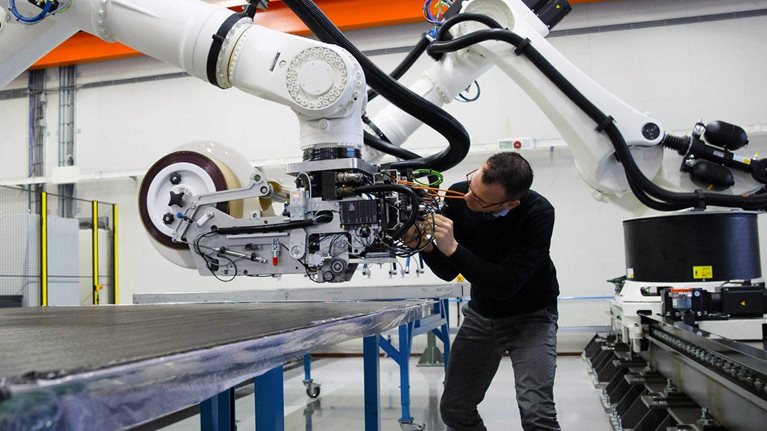Don’t be discouraged by the anemic productivity growth that has handicapped advanced economies for more than a decade. If history is any guide, technology-enabled innovation in processes, products, and services could soon deliver a new wave of productivity growth, with major benefits accruing to players on its leading edge, and to the economy as a whole.
We’ve seen this movie before. Productivity growth lagged in the 1970s and 1980s, despite the computing revolution’s gathering strength. Economist Robert Solow famously said in 1987 that the computer age was everywhere except for the productivity statistics. This phenomenon, which became known as the Solow Paradox, was resolved in the 1990s when a few sectors—technology, retail, and wholesale—led an acceleration of US productivity growth.
In part, the 1990s productivity boom reflected a wave of rapid, fundamental innovation in semiconductors that, along with design and manufacturing-process improvements, boosted their power exponentially in relation to their cost. Semiconductor improvements translated into surging productivity for that sector, and into higher-quality and higher-value inputs for downstream computer-equipment manufacturers, who similarly enjoyed a dramatic productivity improvement.
Also moving the needle were sectors with large labor forces such as retail and wholesale, both of whose productivity had for years been stagnant. When large-format players such as Walmart (in retail) and McKesson (in pharmaceutical wholesaling) used technology to transform supply-chain and distribution-center efficiency, they became both more productive and competitive. Other players responded in both industries, and productivity rose across the board.
The benefits spread further as rapid declines in information, communications, and technology (ICT) equipment prices encouraged an investment boom in a number of other sectors, some of which, such as telecommunications and securities trading, enjoyed rapid productivity improvements.
In short, as companies across the economy evolved business processes, often with the help of an expanding ICT services and software sector, productivity responded strongly in concentrated pockets, moving the needle for the economy as a whole either because the productivity jumps were extremely large or because they occurred in sectors of the economy (such as retail and wholesale) where employment was very large.
Today, with digitization, we are living in round two of the Solow Paradox.
By digitization, we mean the latest digital technology—such as cloud computing, e-commerce, the mobile internet, artificial intelligence, machine learning, and the Internet of Things—that is moving beyond process optimization to fundamentally transform business models, alter value chains, and blur the borders of industries.
Would you like to learn more about the McKinsey Global Institute?
What differentiates this latest wave is the breadth and diversity of innovation. Beyond improving existing business operations, innovation is creating new digital products and features (for example, digital books and live location tracking), introducing new ways to deliver them (for example, mobile directions and streaming video), and enabling new business models (for example, Uber and TaskRabbit).
Digitization contains the promise of significant, productivity-boosting opportunities—but the benefits have not yet materialized at scale. For example, in a recent McKinsey survey of global corporations, only a small fraction of activities and offerings were described as digitized; less than a third of core operations were automated or digitized, and less than a third of products and services were digitized. This is due to adoption barriers and lag effects, as well as transition costs. For example, in the same survey, companies with digital transformations underway said that 17 percent of their market share from core products or services was cannibalized by their own digital products or services.
Today, we find that companies are allocating substantial time and resources to the innovation and adaptation of their businesses. In doing so, many are still trying to understand how to make the most of digital technologies, which often do not yet have a direct and immediate impact on output and productivity growth. Look at some examples.
In the auto industry, opportunities exist to boost productivity through the development of value-added products such as autonomous vehicles, or through greater software content. In 2016, though, only about 1 percent of vehicles sold were equipped with basic partial-autonomous-driving technology. Fast-forward one year, and 80 percent of the top ten OEMs had announced plans for highly autonomous vehicles to be ready by 2025. If technology and regulatory hurdles are overcome, our colleagues in McKinsey’s Automotive & Assembly Practice estimate that up to 15 percent of new cars sold in 2030 could be highly autonomous. That’s significant penetration—but it’s more than a decade out, and still just a small portion of overall sales.
In retail, while online sales are twice as productive as offline, they account for only about 10 percent of total sales today in the United States and Western Europe, according to data from Euromonitor International. Transition costs abound in the realization of productivity benefits, starting with the impact of declining foot traffic in traditional retail stores and malls. Behind the headlines about drone delivery and workerless distribution centers, retailers are working overtime to strike the right “Goldilocks” balance between offline and online retail; their quest will take time.
In the utilities sector, some estimates suggest that digital opportunities such as smart meters and grids, digital productivity tools for employees, and automation of back-office processes could boost profitability by as much as 20 to 30 percent. Investments in digital technologies are still subscale, though, and come with a learning curve. Renewables, too, tend to be more productive—however, wind and solar energy, for example, still comprise less than 10 percent of power generation in the United States and less than 20 percent in Europe.
So where could all these exciting but as yet unrealized digital opportunities lead?
Adding things up for the economy as a whole, our latest research identified potential productivity growth of at least 2 percent per year over the next decade, with about 60 percent coming through digitization. That’s below the roughly 2.5 percent annual rate achieved by the United States in the late 1990s and early 2000s, but well ahead of the 0.5 percent annual average in recent years.
This isn’t just economic arcana. If productivity growth rates do quadruple, it will be because business innovation has caught up with the opportunities created by digitization, and leading companies are pushing the frontier. When the Solow Paradox was unwinding, companies such as AMD, Costco, Dell, Intel, McKesson, Target, Walmart, and a handful of others flourished at the same time as they drove disproportionate, economy-wide productivity improvement. The potential for outsize gains could be even greater this time around because of the scale and network effects associated with digital technologies. That raises the stakes for today’s executives—but it’s also good news. The size of the prize means productivity rates won’t stay low forever. And as they rise, so will a new generation of leading companies.
Revisiting the Solow Paradox
The McKinsey Global Institute (MGI) first tackled the Solow Paradox in a report featured on the cover of McKinsey Quarterly in 2002. A recent MGI report, Solving the productivity puzzle: The role of demand and the promise of digitization, updates the story in the context of today’s digital trends.


